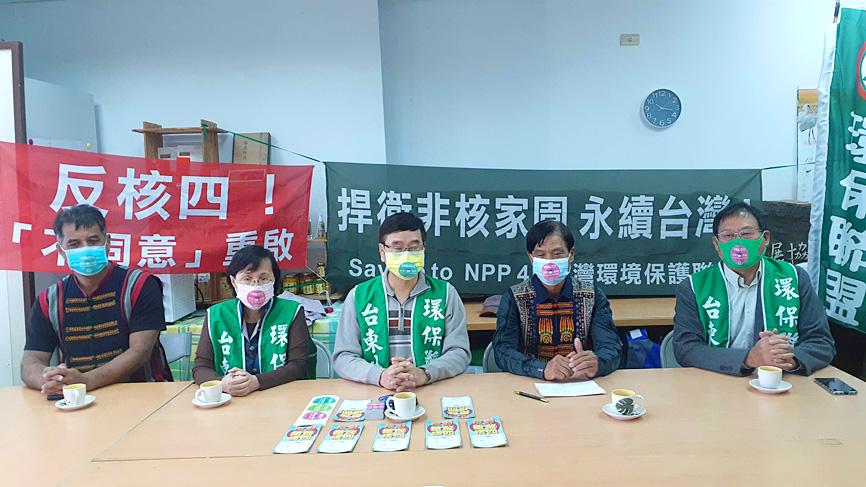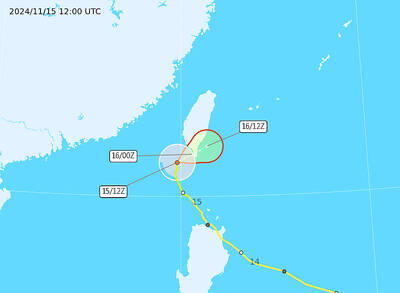An environmental advocacy group yesterday urged people to vote “no” to two of the questions in Saturday’s referendums: restarting construction of the Fourth Nuclear Power Plant in New Taipei City’s Gongliao District (貢寮) and relocating a planned liquefied natural gas (LNG) terminal to protect algal reefs off Taoyuan’s Guanyin District (觀音).
In a news release, the Taiwan Environmental Protection Union said that proponents of the nuclear power plant have made numerous false claims, which the Executive Yuan failed to fully debunk in the Referendum Bulletin issued by the Central Election Commission to explain both sides of the referendum issues.
The Executive Yuan cited difficulties with nuclear waste disposal, incomplete operational tests of the plant, seismic safety issues and technical problems that would take more than seven years to overcome, among others, as reasons for the government’s opposition to the referendum.

Photo: Huang Ming-tang, Taipei Times
The group said it should have gone further by saying that Taiwan shipped out the last of its fuel rods in March, the Fourth Nuclear Power Plant’s building license had expired last year, and one of the plant’s two planned nuclear reactors did not pass operational tests and remains incomplete.
Nuclear energy is not safe, with 16 people killed and 71 injured in accidents involving nuclear power since 1978, when the country activated its first nuclear power plant, the group said, adding that seven of the fatalities occurred on the grounds of the Fourth Nuclear Power Plant.
Nuclear energy is not clean, as nuclear power plants create nuclear waste that would remain radioactive for hundreds or even thousands of years, it said.
A nuclear power plant that is operating normally still produces harmful radionuclides that are released into the air and water, it added.
Heated water discharged by nuclear power plants’ cooling systems has been linked to instances of coral bleaching, it said.
The Fourth Nuclear Power Plant is built over several fault lines and the design is not safe enough to handle a powerful earthquake, it said.
Construction of the plant, which is overwhelmingly opposed by local residents, would negatively affect the future of Gongliao’s tourism and fishery industries, it added.
The Fourth Nuclear Power Plant is prohibitively expensive and has already cost taxpayers NT$283.8 billion, the group said.
In another news release, the group said people should also oppose the proposal to relocate the proposed LNG terminal.
Public discourse about the project has become muddled by the numerous changes made over the years, the difficulty of a highly technical subject and the political rhetorics of the referendum’s proponents, it added.
The project, which involves erecting the breakwater 1.2km from the shore and utilizing an elevated pipeline, is technically viable and minimizes harm to the algal reefs, it said.
Conservation efforts should be geared toward preserving Datan algal reefs as a large, integrated habitat in the long term, instead of protecting a part of the whole for the immediate future, it said, adding that the government has done a good job so far.
The reefs should also be understood as possessing a certain level of resiliency and ability to regenerate, which has ensured their survival against disruptive environmental changes in the past, the group said.
The discussions should take into account the project’s environmental impact, the practicability of alternatives and economic effects, including the country’s issues with power supply, grid balancing and need to transform its energy structure, it said.

Tropical Storm Usagi strengthened to a typhoon yesterday morning and remains on track to brush past southeastern Taiwan from tomorrow to Sunday, the Central Weather Administration (CWA) said yesterday. As of 2pm yesterday, the storm was approximately 950km east-southeast of Oluanpi (鵝鑾鼻), Taiwan proper’s southernmost point, the CWA said. It is expected to enter the Bashi Channel and then turn north, moving into waters southeast of Taiwan, it said. The agency said it could issue a sea warning in the early hours of today and a land warning in the afternoon. As of 2pm yesterday, the storm was moving at

UPDATED FORECAST: The warning covered areas of Pingtung County and Hengchun Peninsula, while a sea warning covering the southern Taiwan Strait was amended The Central Weather Administration (CWA) at 5:30pm yesterday issued a land warning for Typhoon Usagi as the storm approached Taiwan from the south after passing over the Philippines. As of 5pm, Usagi was 420km south-southeast of Oluanpi (鵝鑾鼻), Taiwan proper’s southernmost tip, with an average radius of 150km, the CWA said. The land warning covered areas of Pingtung County and the Hengchun Peninsula (恆春), and came with an amended sea warning, updating a warning issued yesterday morning to cover the southern part of the Taiwan Strait. No local governments had announced any class or office closures as of press time last night. The typhoon

At least 35 people were killed and dozens more injured when a man plowed his car into pedestrians exercising around a sports center in the southern Chinese city of Zhuhai on Monday night. Footage showing bodies lying on the pavement appeared on social media in the hours after the crash, but had vanished by early Tuesday morning, and local police reported only “injuries.” It took officials nearly 24 hours to reveal that dozens had died — in one of the country’s deadliest incidents in years. China heavily monitors social media platforms, where it is common for words and topics deemed

Typhoon Usagi yesterday had weakened into a tropical storm, but a land warning issued by the Central Weather Administration (CWA) was still in effect in four areas in southern Taiwan. As of 5pm yesterday, Tropical Storm Usagi was over waters 120km south-southwest of Oluanpi (鵝鑾鼻), the southernmost tip of Taiwan proper, and was moving north at 9kph, CWA data showed. The storm was expected to veer northeast later yesterday. It had maximum sustained winds of 101kph, with gusts of up to 126kph, the data showed. The CWA urged residents of Kaohsiung, Pingtung County, Taitung County and the Hengchun Peninsula (恆春) to remain alert to